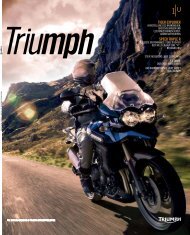Angels - PageSuite
Angels - PageSuite
Angels - PageSuite
Create successful ePaper yourself
Turn your PDF publications into a flip-book with our unique Google optimized e-Paper software.
AMAZONAS<br />
72<br />
Above: Pseudomugil gertrudae, the Spotted Blue-Eye from the Aru<br />
Islands south of Papua New Guinea, is bred in large numbers.<br />
Left: For breeding killifishes, rainbowfishes, and blue-eyes we use<br />
spawning mops made of artificial wool, which are transferred to the<br />
rearing unit when sufficient eggs have been laid.<br />
remove the peat, put it in a fine-meshed net, and squeeze<br />
out the water with my hands. I then put the still slightly<br />
damp peat into a plastic bag and store it at around 77°F<br />
(25°C), affixing a label detailing the contents and the<br />
date of removal. After three weeks have elapsed the peat<br />
is placed in a rearing tank filled with aquarium water.<br />
After just an hour the first fry swim free. During their<br />
first days of life they are fed with infusorians and Artemia<br />
nauplii. Once they are .75 inch (2 cm) long, they can eat<br />
coarser frozen foods as well. Frequent feeding will ensure<br />
continuous growth.<br />
The aquarists of tomorrow<br />
During seminars to educate staff in the pet trade, and<br />
based on comments made by groups of visitors, we have<br />
noticed that the breeding of ornamental fishes and<br />
reptiles helps create increased interest. That led us to the<br />
idea of inviting school classes to our facility. We divide




